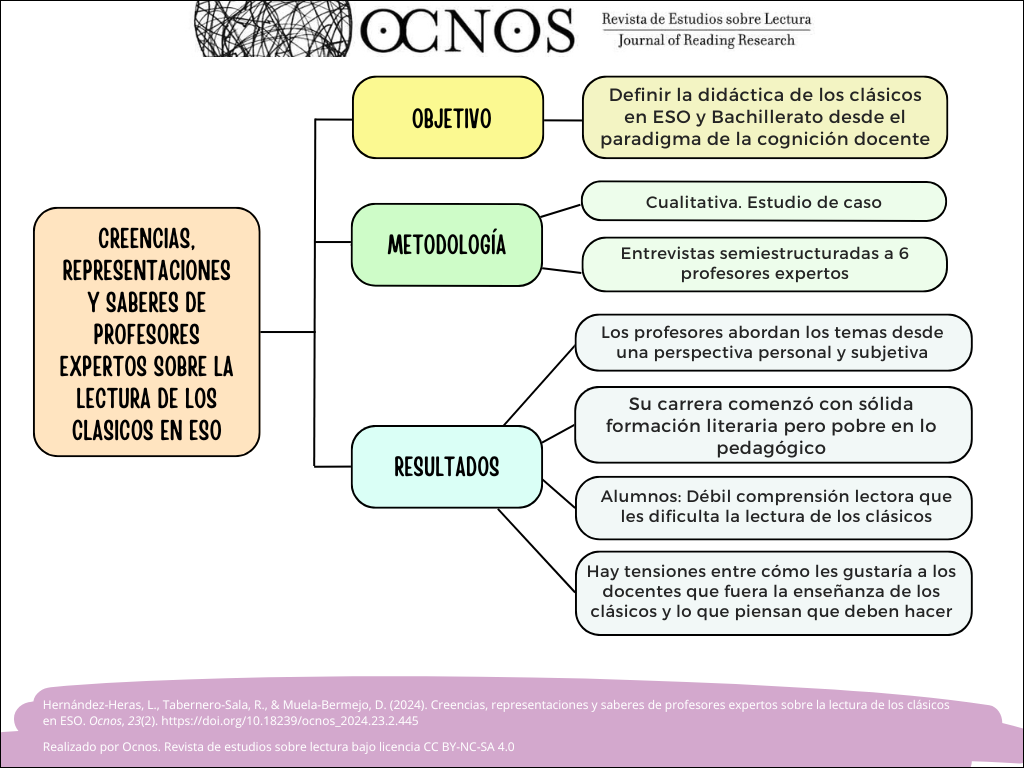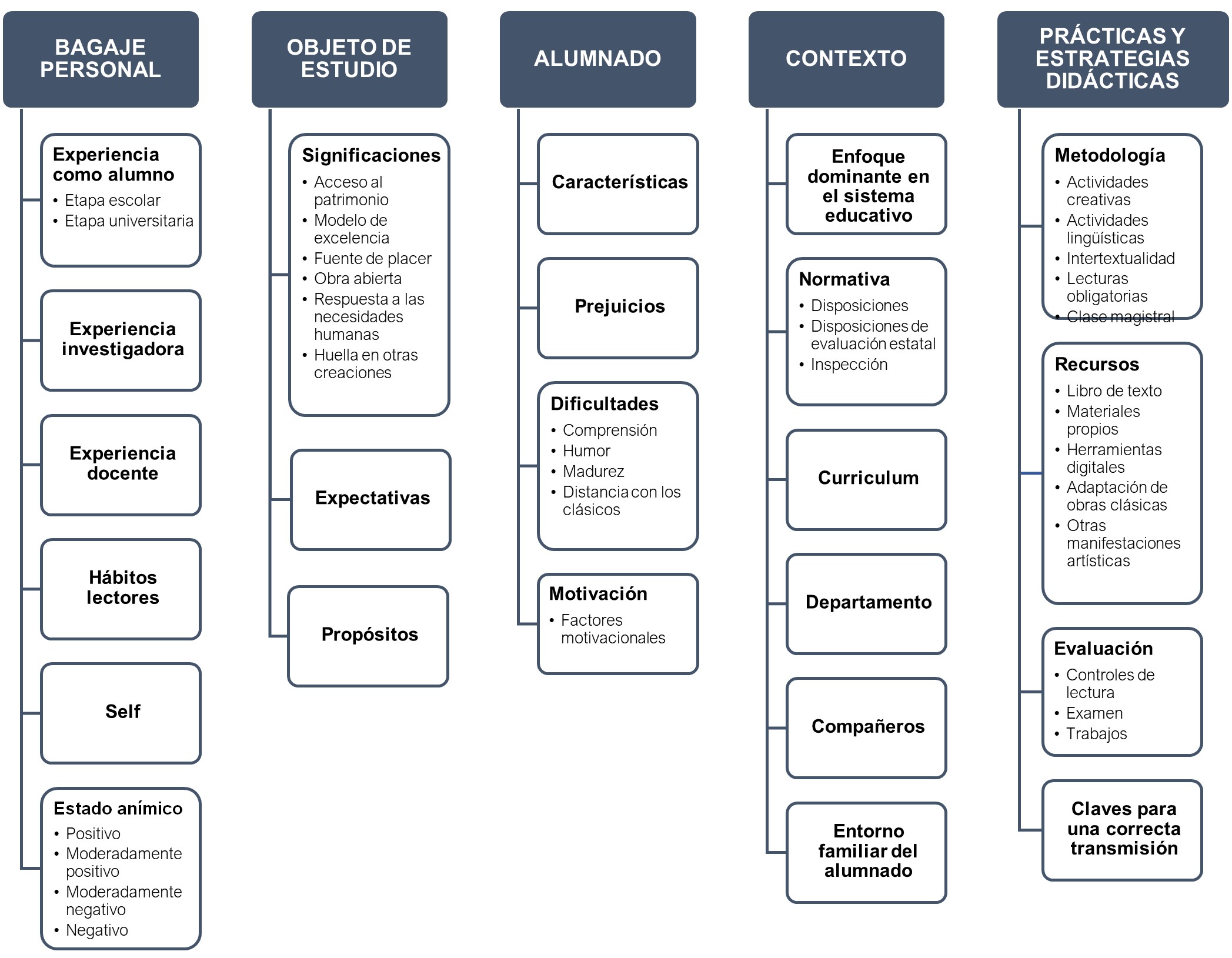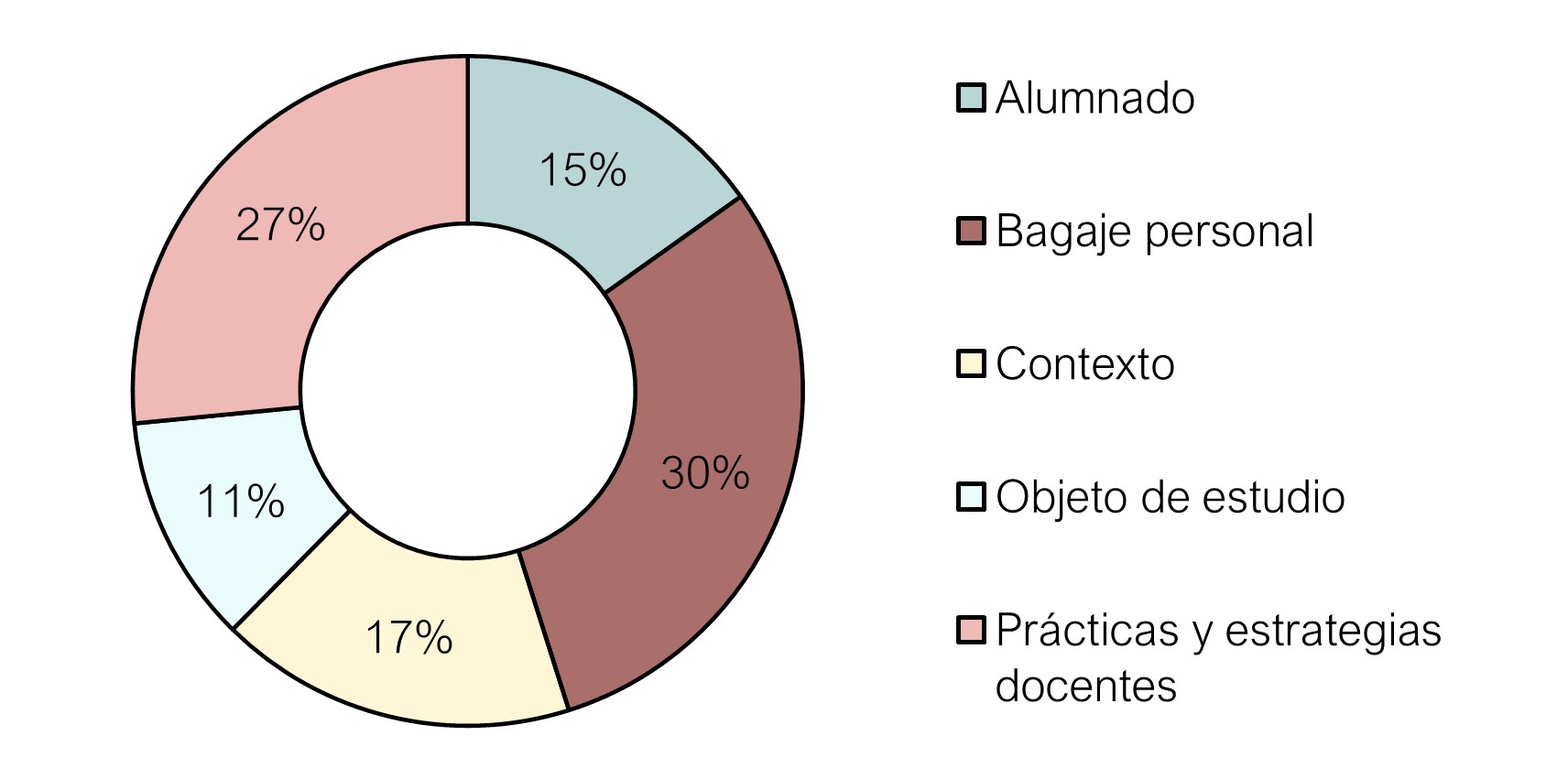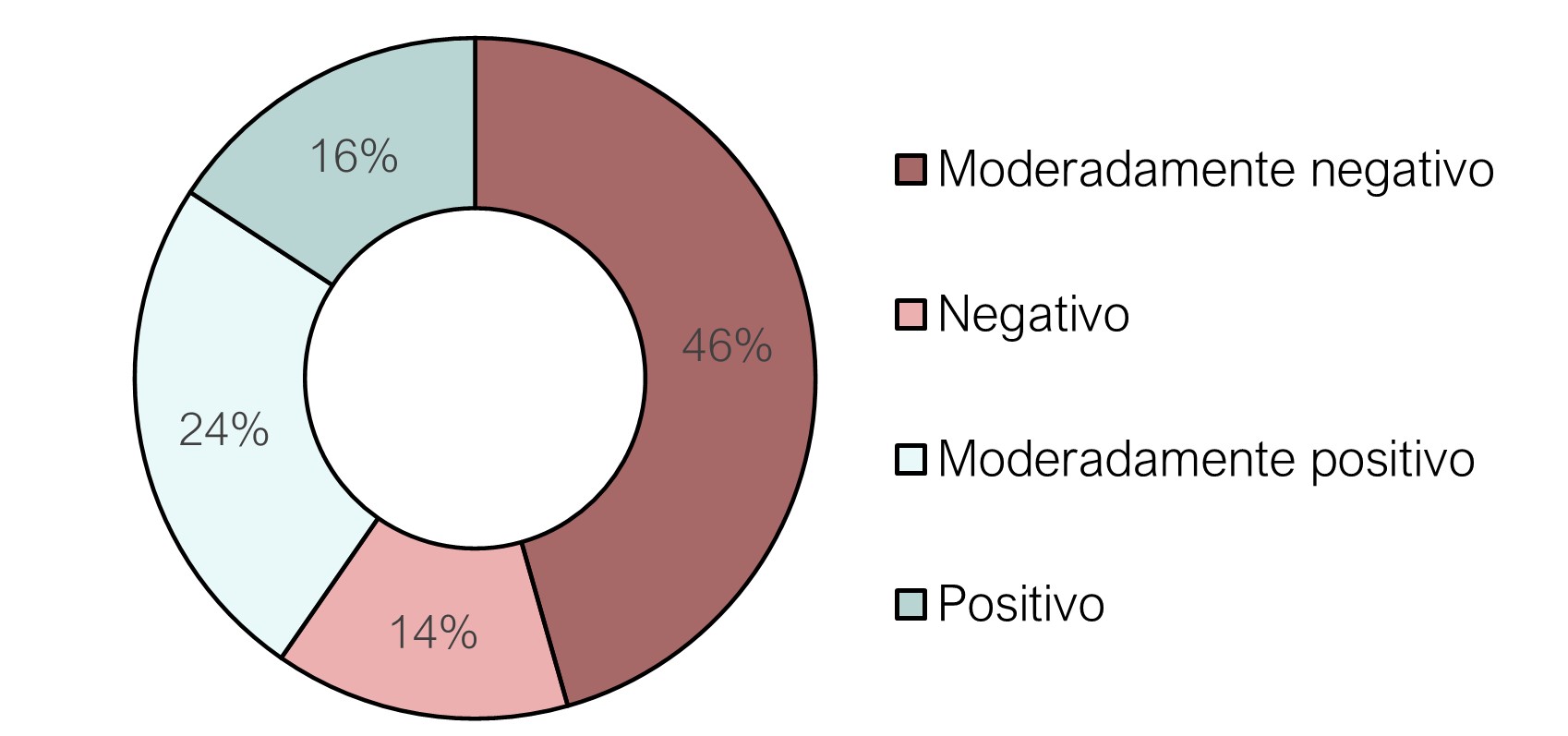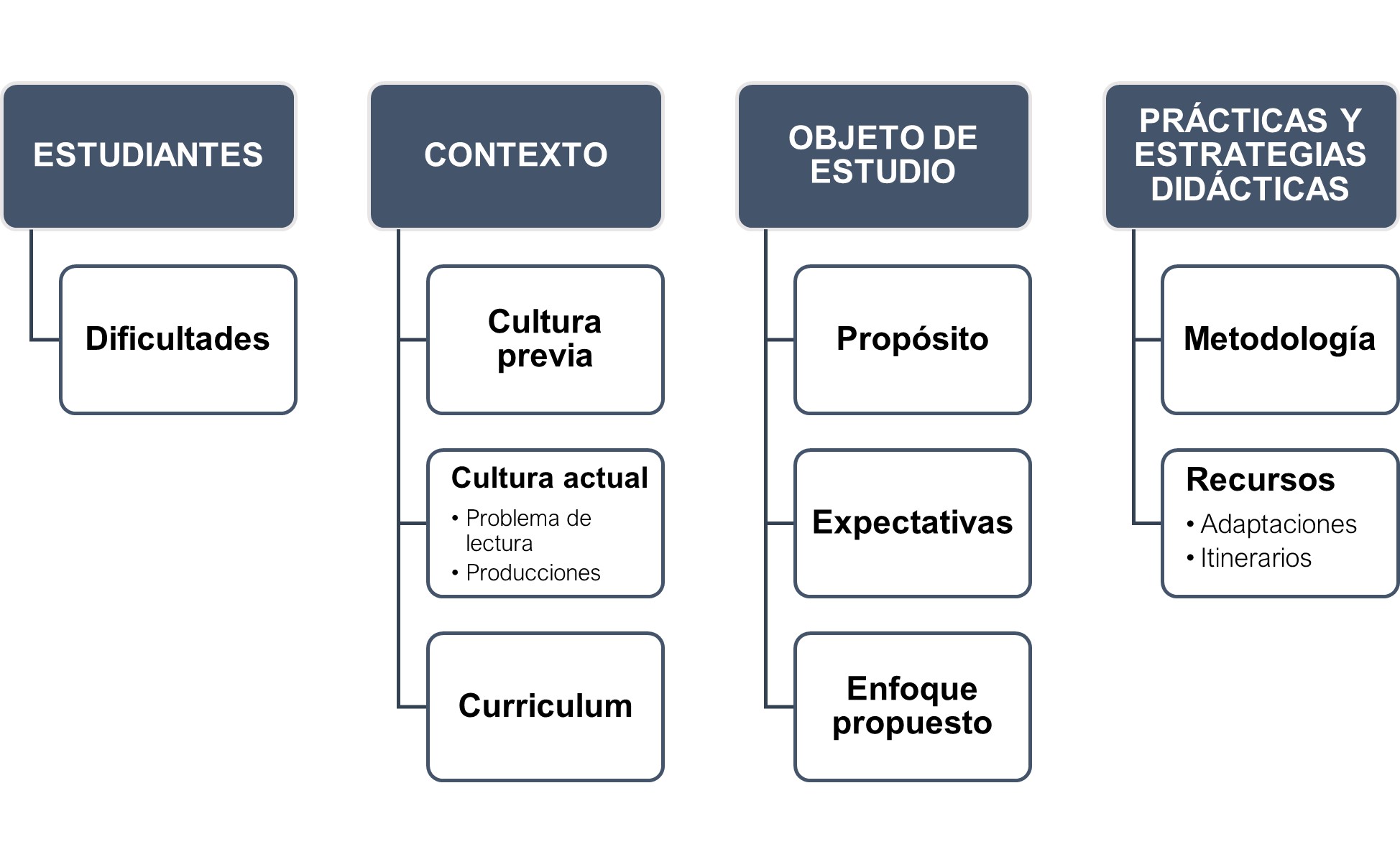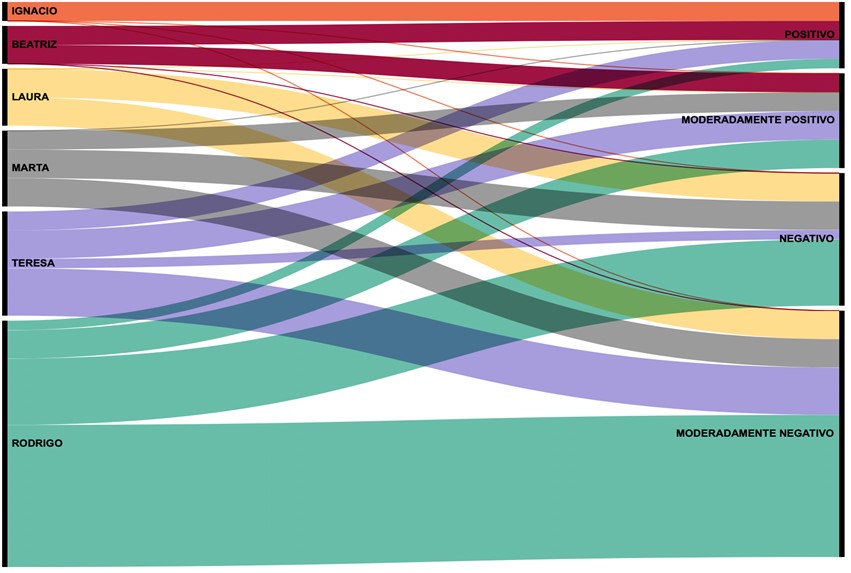Interviews results
The system of categories of the interviews is shown in figure 2.
Figure 2Framework of categories (interviews)
According to figure 3, the macro-category ‘personal background’ has the highest percentage of coverage,
followed by ‘teaching practices and strategies’. These results show that teachers
approached the issues from a personal and subjective perspective.
Figure 3Saturation of each macro-category (interviews)
CRS on the personal background of the teachers
Among his categories, the return to their student days was the focus of many of their
observations. All agree in emphasising the historicist approach that characterised
his time at school, although the structuralist model also played a role. Nevertheless,
the teachers have fond memories of their time at the school, which instilled a love
of literature that continues to this day. Teachers recall that the historicist approach
also dominated the classics teaching they received at university. As a result, the
lack of pedagogical content on classics in both the undergraduate course and the Certificate
of Pedagogical Aptitude –now replaced by a Master’s degree– meant that teachers who
passed the competitive exams entered the job market with a solid literary background
but little pedagogical training.
In general, knowledge of the informants’ teaching practice has been generated through
a process that is characterised by its arbitrariness and lack of certainty. Their
learning, reinforced by testing, is based on a succession of successes and failures.
This constant testing, and the wear and tear of error, has an effect on the approach
of teachers, who inevitably become more practical:
Teresa: “hombre, vas probando, vas probando y ves actividades que gustan más que otras::
es cuestión de ir adaptándose y rebajando tus expectativas” (You try, you try and
you see activities that you like more than others:: it’s a matter of adapting and
lowering your expectations).
The development of their experience has led to the articulation of their self, characterised
by their commitment to the work they do and their sense of responsibility. Rodrigo:
“intento hacerlo lo mejor posible” (I try to do my best). Feeling obliged to perform
activities in which the informants do not believe in has led to mostly negative feelings
about their performance (figure 4).
Figure 4Percentage coverage of the sub-categories of “State of mind”.
Therefore, teachers feel that they are making great sacrifices in order to achieve
minimum standards, even if this means abandoning their own teaching principles:
Rodrigo: “me obliga a hacer cosas en las que realmente no:: no creo mucho pero por
sentido del deber” (I am foreced to do things I don’t really believe in:: I don’t
believe in much, but out of a sense of duty).
However, teachers report that despite the difficulties, they find their job very rewarding
when pupils get to experience reading. On an individual level, Ignacio only sees the
positive side of his exercise.
In parallel with their teaching practice, they have built up research careers that
have left their mark on their teaching projects. Teresa: “yo hice la tesis sobre libros
de caballerías y la he conectado un poco con la novela fantástica actual”(I did my
dissertation on books of chivalry and linked it a bit to the current fantasy novel).
Another aspect that determines their teaching practice and experience is their reading
habits, which are directly linked to canonical readings.
CRS on teaching practices and strategies
Teachers report that they regularly carry out activities aimed at developing students’
literacy skills, as well as their creativity and motivation. Everyone agrees on the
importance of reading in class. This practice is fundamental to instilling a passion
for literature and encourages a communal reading that encourages participation and
a greater understanding of the text.
A more complicated issue is that of compulsory reading. While Ignacio and Laura try
to leave the students some freedom of choice, Marta and Rodrigo question its voluntary
nature, arguing that it is their duty to expose the students to works that are a priori inaccessible to them, but that will optimise their skills and their vision of the
world.
The complete works to be read by students individually or collectively are always
presented in an adapted version. Although the adaptations make reading easier, it
is also true that they modify the first edition in one way or another. However, the
objective is to give students an understanding of the motifs and history of the classical
work; the enjoyment of the language as it was composed is secondary.
Teachers use three formats to assess Classics: Reading tests, examinations and assignments.
The former are the most controversial. On the one hand, Beatriz and Teresa are absolutely
against it, because its rigidity constrains the students’ ability to express themselves,
while its coercive nature contradicts any attempt to convey a pleasurable vision of
literature. On the other hand, Concha, Marta and Rodrigo argue that this is the quickest
way to get the students to read the books because they know they will get good grades
if they do.
It is essential for teachers to give meaning to the subject they are dealing with
so that students find an incentive to approach their works: it is a question of making
them understand that reading is not a means of passing on or accumulating knowledge
of general culture, but that it has a usefulness, an end in itself, which is directly
related to their constitution as persons:
Marta: “me parece fundamental | que vean que la literatura puede acompañar | y dar
respuestas | que no es una imposición del instituto” (I think it is fundamental for
them to see that literature can accompany them and give them answers, that it is not
an imposition from the Institute).
In order to achieve this goal, informants reiterate the importance of linking the
reality of the classroom with that of the student. To do this, teachers need to get
to know the student before planning their methodology: to know their interests and,
from this approach, what aspects of the works might appeal to them. Throughout this
pendulum-like process, from approaching the students to approaching the classics,
preparatory work is essential to pave the way. Mediators must therefore act as guides
along a path that students would not follow without their guidance:
Rodrigo: “el adolescente es inmaduro necesita esa confianza que le da el profesor
por una vía o por otra” (adolescents are immature and need the confidence that the
teacher gives them in one way or another).
CRS on the context
The restriction of teachers’ autonomy is a recurring theme in informants’ descriptions
of state evaluation regulations, which they criticise for their historicism and rigidity.
The abundance of literary units that they have to teach in the second year of the
GSCE, from the 19th century to the limits of the 20th century, means that they have to teach a lot of content that they can only mention
in their classes due to lack of time. This is because they recognise that the focus
is mainly on the readings of the University Entrance Examination (hereinafter “EvAu”).
Although they are aware that this approach promotes a very superficial approach to
literature, they feel a responsibility to follow their aims for the sake of the students’
future, as this is what the EvAu requires:
Rodrigo: “mi frase de este año es ‘perdonad que he estado hablando sin parar’ | porque
si no sabes que no llegas a cumplir con todo | y ellos tienen que llegar a la selectividad
bien preparados” (my phrase this year is ‘sorry, I’ve been talking non-stop’, because
if you don’t know, you can’t do everything and you have to be well prepared for the
EvAu).
If the inflexibility of the EvAu elicits a unanimous response, the teachers’ view
of the curriculum is rather the opposite in terms of its degree of flexibility. While
Beatriz, Teresa and Ignacio celebrate the freedom stimulated by the curricula, which
are open-ended and not very concrete, Laura and Rodrigo deplore the authoritarianism
to which they submit for the sake of the students:
Laura: “el currículo te condiciona mucho a no ser que uno se lo salte | pero tiene
repercusiones para ellos porque todo el sistema se organiza a través del currículo”
(the curriculum conditions you a lot unless you skip it | but it has an impact on
them because the whole system is organised through the curriculum).
Departments also exercise their power in both selection and evaluation. As the school
promotes the reading of the classics and makes it a central part of school policy,
the teacher’s job becomes much more enjoyable and accessible, they say. Although coordination
between colleagues at different levels can be problematic, they also underline the
mutual learning that coexistence between different professionals promotes, which also
stimulates relationships of empathy and solidarity.
Contrary to the differences of opinion generated by the other components of the educational
system, family culture is uncontroversial: all opinions stress its importance in consolidating
the reading of the classics. Families with a reading habit, willing to spend money
on books or who instil the values of culture are the first link in the chain.
CRS on students
Teachers’ characterisation of students is defined by the concept of generational difference:
students are not like them. The multiple stimuli of their environment have created
a boundary between their current profile and the students they were. With so many
leisure activities on offer, reading the classics tends to take a back seat.
Students also have certain prejudices about classical works. The historical approach
leads students to imagine their reading as an obligatory visit to some ruins, so that
they associate it with boredom and disproportionate sacrifice, which undermines their
motivation. Learning the classics is meaningless for students:
Laura: “llamarlos clásicos ya hacia ellos les hace: “jo un clásico” | les suena aburrido
para la mayoría” (to call them classics makes them go like: "pfff, a classic" - sounds
boring to most).
These preconceptions include a certain inferiority complex in the face of the greatness
of the classic, which translates into an initial fear when confronted with its pages.
However, when they overcome this self-imposed barrier, they enjoy the journey and
are proud not only of the fact that they feel they can take on a prestigious mind,
but also of the effort they have put in. As a result, the learner feels fulfilled
by reading:
Marta: “se creen incapaces de acceder a ellos | y cuando les obligan y lo consiguen
es como hacer el test de Cooper en 8 minutos” (they think they are incapable of accessing
them, and when they are forced to and they succeed, it’s like doing the Cooper test
in 8 minutes).
In order for this transition to take place, there are a number of motivational factors
that directly influence students’ behaviour towards literature. Teachers emphasise
the work of the mediator, the teaching approach and the texts as the main factors,
since some authors, such as the poets of the Spanish ‘27 generation or Bécquer, tend
to attract pupils because of their ability to stir the emotions of the recipients.
However, students’ engagement in the teaching-learning process is not only a matter
of attitudes: their skills are also crucial. In this context, teachers bring up the
difficulties that pupils have in interpreting and enjoying the classics. The main
problem is their poor reading comprehension, which prevents them from going beyond
the literal. Directly linked to poor literacy skills, this fragile interpretive ability
makes it impossible for them to understand complex structures and develop their own
interpretations that would give them a true reading experience. Precisely because
they only have access to a first-level reading, they are far from being able to identify
deeper mechanisms, which border on the realm of the unspoken and require a certain
capacity for abstraction. So humour and speaker-splitting techniques such as irony
are a big problem.
Laura: “no se ríen nunca con los pasajes | es que no entienden los juegos” (they never
laugh at the passages | they just don’t understand the games).
Moreover, because they are young and have not yet experienced disappointment or collapse,
students can only be satisfied with a limited view of some fictional universes, which
rightly occupy the pinnacle of literary history because they are rooted in the deepest
and darkest part of the human psyche:
Marta: “ellos no se plantean esos problemas | no tienen nada que ver con su vida |
es una edad en la que | no hay madurez suficiente para alcanzar todos los objetivos
que se pretenden” (they don’t think about these problems | they have nothing to do
with their lives | it’s an age when | there’s not enough maturity to achieve all the
goals you’re striving for).
Moreover, the distance between the implicit reader of the work and the student who
receives it opens up a friction between the two instances that is manifested through
language. Laura: “su escritura les resulta muy difícil muy lejana” (their writing
is very difficult for them very distant).
CRS on the subject matter
Throughout the interviews, the meanings that informants attached to the category of
classic emerged. Firstly, they stressed that these works could serve as a guide for
their readers in the face of any life event. The impact of the classic goes beyond
individual margins:
Rodrigo: “esto desborda el individuo | o sea la literatura tiene un sentido para la
especie humana” (this goes beyond the individual | i.e., literature has a meaning
for the human race).
Because of the greatness of the classic, each work determines the next. Teachers thus
see classical literature as a network of connections in which similarities prevail
over differences. Moreover, the greater the knowledge of the canonical titles, the
greater the enjoyment of any artistic manifestation. Because of their extraordinary
quality, classical works have no single meaning, which frees the empirical reader
from the implicit. Moreover, not only do they contain the essence of the human being,
but also the reality of the environment in which they were born. This monumental value
is the source of its didactic potential:
Marta: “el clásico tiene un valor per se | que representa una época | una época de
la que se puede aprender mucho” (classics have a value per se | they represent an era | an era from which much can be learned).
Based on these beliefs about the concept of classics, teachers teach the works of
these authors for a number of purposes. From a theoretical point of view, the concept
of a pathway is of paramount importance, i.e., that students should be aware that
these degrees are the starting point of a pathway, without which the present cannot
be understood. The most important thing, however, is to strengthen their reading habits.
In relation to this objective, teachers try to make the lesson a reading experience
that can influence the student’s identity, given the performative capacity that characterises
the classical work as a sublime product:
Rodrigo: “enseñamos porque queremos que la literatura sirva para algo para el ser
humano” (we teach because we want literature to serve a human purpose).
Teachers share the conviction that only a collective proposal, supported by the entire
educational system, will bring about a real evolution in the reading of the classics,
since individual initiative is insufficient in the face of the multitude of circumstances
that condition it:
Rodrigo: “tiene que ser una apuesta colectiva por resituar el sentido de la enseñanza
literaria” (it should be a collective effort to reinstate the importance of literary
education).

